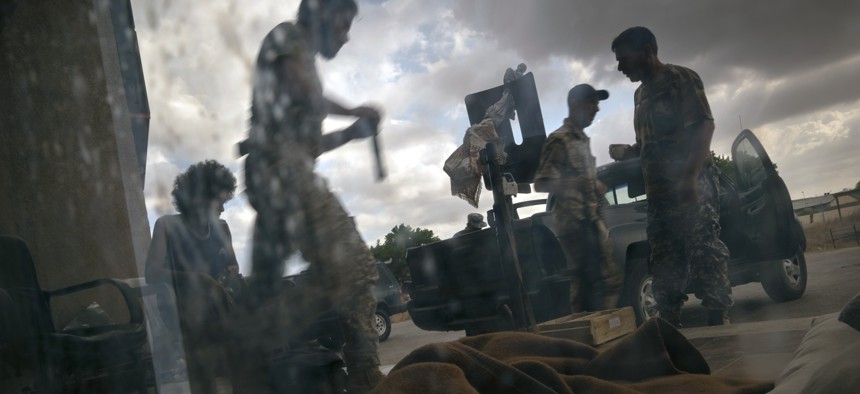
In this Saturday Sept. 7, 2019 photo, fighters of the 'Shelba' unit, allied with the U.N.-supported Libyan government, prepare for combat at the Salah-addin neighborhood front line in Tripoli, Libya. AP / Ricard Garcia Vilanova
Can Anything Stop the Flow of Advanced Weapons into Libya?
If the country becomes a nexus for expertise and arms, increasingly deadly regional armed groups could destabilize the region.
Amid intense clashes around southern Tripoli, Libya’s capital has become a proving ground for foreign military equipment. In flagrant violation of the U.N. arms embargo on Libya and with dire consequences for the country and region’s security, foreign actors have injected drones, armored personnel carriers and advanced missile systems into the battlespace.
Reports of increasing Russian military intervention on behalf of Khalifa Hifter — whose forces are trying to capture the city — has made Libya suddenly a high-attention, bi-partisan issue in Washington. In Congress, the Libya Stabilization Act, co-sponsored by four Democrats and one Republican, was introduced in the House in October. A bill by the same name co-sponsored by two Democrats and two Republicans was introduced in the Senate last month. The bills aim to clarify U.S. policy in Libya, identify and highlight foreign meddling and violation of the arms embargo, and establish a strategy for countering Russian influence in Libya.
Certain members of Congress are also preparing to respond to Russian mercenary actions in Libya with sanctions. And on Nov. 14, the U.S. State Department issued a joint statement calling on Hifter’s group to “end its offensive on Tripoli” and condemning “Russia’s attempts to exploit the conflict.” All this movement could lead to progress in holding violators of the U.N. arms embargo accountable and stopping the flow of weapons into Libya.
Weapons proliferation has been a security concern for Libya and its neighbors since the revolution of 2011, when militias looted the Gaddafi regime’s stockpiles of light weapons. Through the 2014 onset of the Libyan civil war, regime-era arms proliferated into the Sahel, the rest of North Africa and the Levant. Plundered weaponry spread as far afield as Syria and exacerbated instability in other conflict-affected countries, such as Mali and the Egyptian Sinai.
Related: Trump Officials Meet With Libyan Politician Aligned With Opposition ‘Strongman’ In Potential Policy Shift
Related: A Warlord Rises in Libya, and Trump Is Praising Him
Related: Europe Should Do More for Regional Security — Starting with Libya
The flow of arms into Libya never stopped, but the outbreak of civil war in 2014 and its reinvigoration last April saw the intensification of state-provided arms transfers to the conflict’s strongest belligerents. Today, the UAE, Egypt, Jordan, France and Russia are supporting Hifter’s self-titled “Libyan National Army.” Turkey meanwhile is backing the collection of militias tangentially aligned against Hifter. As a result, advanced military equipment is now flooding into Libya by air, land and sea.
Weapons previously unseen in the conflict have now arrived. Videos have circulated purporting to show anti-Hifter fighters using an advanced Chinese-made FN-6 man-portable air defense system to shoot down an MiG-21 jet fighter. Hifter-aligned forces have posted videos of themselves using anti-tank guided missiles to destroy enemy vehicles and using thermal sights of advanced Russian-made ATGMs for targeting and reconnaissance. U.S.-made Javelin ATGMs were discovered in Gharyan, south of Tripoli, when anti-Hifter forces captured that town in June.
That such armed groups are deploying advanced weapons has dangerous implications. With continued exposure to and training on such systems, Libyan armed groups’ capabilities will become increasingly sophisticated and deadly. Moreover, as they continue publishing novel uses of their advanced weaponry online, other armed groups stand to learn and benefit. Like in Afghanistan in the 1990s and 2000s — as well as in the Sahel in the 2010s — militants from other armed groups may come to Libya to receive training.
If Libya becomes a nexus for growing expertise and potential outflow of arms, increasingly deadly regional armed groups could further destabilize the region. As was the case between 2012 and 2014 when Libyan arms bolstered the arsenals of terrorist and separatist groups, light weapons could proliferate into Libya’s fragile neighbors, a number of which are grappling with mounting ISIS- and Al-Qaeda-linked insurgencies.
To preempt such a destabilization spiral, U.S. policymakers could work to reduce foreign meddling in Libyan affairs, which is stoking the conflict. The yet-to-be-scheduled Berlin Conference, which will address foreign meddling in Libya’s civil war, may be a venue for such progress. Additionally, the U.N. has taken important steps in specifically denouncing violations of the arms embargo, calling out three of the most troublesome actors — the UAE, Turkey and Jordan.
The UAE may be particularly susceptible to such negative international attention, given its reaction to heightened congressional scrutiny for its involvement in Yemen. Turkey might also positively respond to international pressures — Ankara de-escalated its October offensive into northeastern Syria amid threats of U.S. sanctions.
Such steps won’t eliminate the indigenous drivers of Libya’s crisis, but they may help curtail foreign involvement and restart the U.N.-led reconciliation process. If foreign arms transfers into Libya aren’t reduced, the country’s security situation will continue to deteriorate, giving militant groups a chance to increase their lethality and further destabilize the region.
Nathan Vest is a research assistant and Middle East specialist at the nonprofit, nonpartisan RAND Corporation.
NEXT STORY: Democrats Retreat on Nuclear Policy



